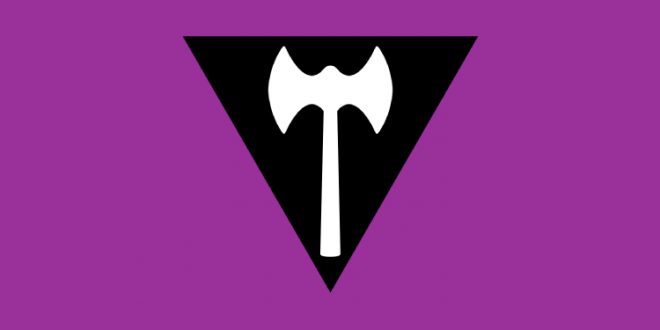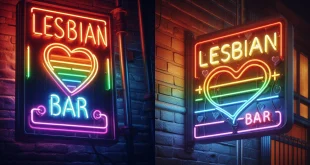I am one urban dyke transplanted to the wilds of Kentucky who has received the honor of writing about the movement of which I am a part. There is no “typical” representative of us, so I write from my experience and knowledge, having lived in a rural lesbian community for over ten years. In this article you will see the words “wimmin” for “women” and “womyn” for “woman.” Not a typo, it is common among some feminists and lesbians to use a word that does not make females derivative of males or men. Wimmin are not the outgrowth of Adam’s rib, and many of us have created alternative spellings for our gender such as womon, womoon, and wems.Since OWL (Oregon Women’s Land) farm was established in 1975, there has been a small but growing number of intentional communities formed specifically for lesbians in North America. After OWL’s pioneering efforts, so many settlements started up in Oregon that the roads leading to them have been loosely named “the Amazon Trail.” Lesbian land also exists in New Mexico, Arizona, Louisiana, Florida, Quebec, British Columbia, Kentucky, Mississippi, California, Virginia, Wisconsin, Kansas—just about everywhere!What Kinds of Community?Kate continues: Lesbian land ranges from one or two wimmin who welcome female travelers to their home to well-established groups of a dozen residents. It may consist of a one-acre lot at the edge of town, a 700-acre rural tract of land, or anything in between. The focus of a land group may be on farming and self-sufficiency, art and culture, politics, or simple survival, to name a few.One of the more famous efforts at establishing new ways of living for wimmin is Seneca Peace Camp in Seneca, New York. A political antimilitary action group, Seneca is a small farm bordered on one side by an Amish family and on the back by a military compound. It has been a staging ground for many peace actions, as well as home to numerous wimmin who are dedicated to the peace movement. The core group lives there year round and governs itself by consensus.
During Seneca’s heyday, when actions were planned, acres of tents would appear and organization was crucial. The “affinity group” method allowed for consensus among each small group of wimmin who traveled and worked together, with representatives from each group participating in consensus decision making for the whole. One example of their activities was a nonviolent attempt to block the entrance to the military base when it was discovered that nuclear missiles were being transported in trucks labeled as if they were carrying food or auto parts. While the military’s attention was on the gates, several wimmin sneaked in the back and then telephoned the front gate guards to let them know they’d been invaded.
One of the military’s responses to the camp’s presence was continual helicopter surveillance. One summer some wimmin climbed on the farmhouse roof and painted a huge spider web surrounded by the words “You can’t kill the spirit!” which was a popular slogan and song.
The form of the peace movement has changed, but Seneca Peace Camp remains a source of education on a smaller scale, hosting lesbian-feminist conferences and retreats.
Back to the Land Movement
The “back to the land” movement by lesbians is part of the overall lesbian feminist focus on the Earth as female, the creatrix who birthed us all. We are an extremely diverse bunch; the term “eco-feminist” might just be the only label that fits everyone. A concern for the preservation of the natural environment and a search for an unpolluted place to live motivate many to live simply, in a place where food comes from gardens on the land and where everyone knows what happens to their sewage.
The ecology motive is familiar to all who seek rural community living. The lesbian feminist part is unique to our movement. Almost all those who seek wimmin-only space have been touched by the joy of recognizing the power in each of us to create lives that suit us, rather than lives handed down from patriarchal institutions.
Each settlement is different in size, shape, rules, and traditions. Most wimmin’s land is populated by lesbians, not straight or bisexual wimmin. However, in my community, Spiral Land Trust for Wimmin, we choose to create community with wimmin, not specifically lesbians. Some wimmin who do not identify as lesbian have considered living here, but not very often. Their male partners and boy children could not move here, although male relatives and friends can and do visit. There are many opinions about our wimmin-only policy, but the bottom line to us is that a community of wimmin is not a community that includes male energy. This is difficult for wimmin with sons, but there are other wimmin’s communities that do accept boy children.
We maintain good relations with our neighbors, people who may not ever have left the county. When I first moved to Spiral, I found myself having many more conversations with neighbors, especially men, than I had ever had in the city. They almost always observed, “Yer not from around here, are ya?” My explanation, that I was from Tennessee, seemed to satisfy them, even though we live only 25 miles from that state. Our peace and security rest in the fact that we are considered “good neighbors,” allies who look out for each other and band together in emergencies.
Why do wimmin seek to establish a separate place for ourselves? Some would say it just makes sense to them. I have come up with a western, herstorical (that’s female for history, folks) answer. Wimmin have lived for thousands of years in our fathers’ houses, then our husbands’. At times we have been actual slaves owned by men, at times it was figurative. Even escaping to a nunnery meant being a bride of Christ, obedient to the priest and pope. The modern city womyn usually works for “the man,” just like everybody else.
Lesbians have always been around, surviving as best we could and slowly developing a culture based on our own experiences, separate from the dominant culture. Now we have the chance to create culture deliberately, as we listen to each other in growing numbers, as we each speak our hearts. Wimmin-only space is the only place that is not run by men at all, and it feels very different.
Lesbian land gives wimmin the chance to build our own homes, barns, studios, outhouses. For many, the creative direction and implementation of a project, a home for herself or her friends, is profoundly life-changing. Female conditioning has led most of us to be comfortable assisting, not taking charge. Or we give directions but rely on a man’s expertise and strength to get the job done. Now, even when there is a project leader, we share skills and create together.
Lia, who recently moved to Spiral, told me, “I feel a sense of empowerment I never had before. I am respected and taken seriously in a way that never really happened before moving here. I have a grown son that I dearly love; I certainly don’t hate men. However, men live and take for granted a kind of entitlement, it’s in their bones, and they don’t necessarily mean to treat you different, but they do. It’s a rare man that can treat everyone equal, and I’m tired of looking for him.”
Another new resident of Spiral used to have her own farm a few hours from here. Gina says, “As a womyn, you can’t get any help on the farm. You can’t go down to the corner store and hang out with the guys, then ask some of them to come over and help with the fencing. When other farmers did help me, it was like the help they give a womyn—someone that’s looked down on, or a possible opportunity for sex. And of course they never want me to help them, because I was just a womyn. Wimmin don’t do that kind of work, none of their wimmin do. Besides, I like being around other wimmin, having a social life, being myself. In community with wimmin, I feel safe. I no longer have to look over my shoulder.”
Everyday living has its frustrations and misunderstandings, no matter where you hang your hat. Yet sometimes I feel inspired by the work and the play that we engage each other in. It gives my life meaning the way nothing else ever has. Perhaps you feel that way about your community. I am grateful that we have enough freedom and sense of adventure to make these choices.
I appreciate the opportunity to learn from other wimmin in an environment of respect. We may have different backgrounds, but our commonalities as wimmin, and especially as lesbians, help me feel that I’m working with my own group. The support, understanding, and shared experiences make it easier. The only way to really know the difference is to experience it yourself.
The following addresses are given to help lesbians reading this article connect with the wider community of rural lesbians and wimmin’s land. Please respect our intent.
- Lesbian Natural Resources (LNR), a networking source for lesbian communities, was established over nine years ago to be a resource for community-owned (not-for-profit) lesbian lands and rural lesbians in Canada, Mexico, and the United States. LNR has a program for sharing rural living skills through its apprenticeship program. It does not maintain a contact list of rural communities to visit. For more information, write LNR at PO Box 8742, Minneapolis MN 55408, USA.
- Shewolf publishes a 64-page directory containing “the philosophies and contacts for over 75 wimmin’s settlements in the United States and Canada.” To order, contact: Royal T., 2013 Rue Royal, New Orleans LA 70116, USA. Email: Wimminland @aol.com members.aol.com/shewolfww/fave/index.htm
Author Biography
Kate Ellison has lived for 10 years at Spiral Wimmin’s Land Trust in Kentucky. Email katespiral at juno.com.
– See more at: ic.org/wiki/lesbian-intentional-community-yer-around-ya/#sthash.jmTozMGq.dpuf
Kate Ellison writes : (Taken from the site of Lesbian International Community)
Paula, 2014, stories4hotbloodedlesbians.com
 Lesbian, Gay, Bisexual, Transgender & Intersex News Lesbian News, Gay News, Bisexual News, Transgender News, Intersex News, LGBTI News
Lesbian, Gay, Bisexual, Transgender & Intersex News Lesbian News, Gay News, Bisexual News, Transgender News, Intersex News, LGBTI News




